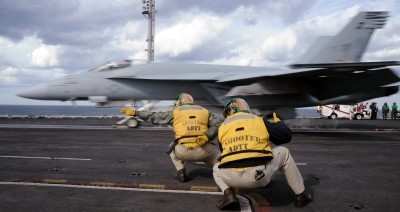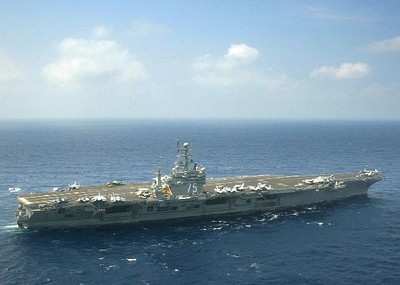Carrier Qualifications Are "The Pinnacle Of Navy Pilots'
Training"
Pilots from five Fleet Replacement Squadrons (FRSs) embarked
aboard USS Harry S. Truman (CVN 75) began the final stage of their
pilot training, Jan. 27. The pilots have conducted more than 800
launch-and-recovery cycles since they embarked Truman and are
meeting specific standards and qualifications to become
carrier-qualified (CQ) pilots.

U.S. Navy Photo
Pilots from "The Gladiators" of Strike Fighter Squadron (VFA)
106; "The Rawhides" of Fleet Logistics Support Squadron (VRC) 40;
"The Vikings" of Electronic Attack Squadron (VAQ) 129; "The Flying
Eagles" of VFA-122; and "The Greyhawks" of Carrier Airborne Early
Warning Squadron (VAW) 120, spent five days working toward their
carrier qualifications. "These are all fleet replacement pilots,"
said Chief Aviation Electrician's Mate (AW/SW) Michael Collins.
"Before these pilots move on to fleet readiness squadrons, they
have to complete this training. Upon graduating, they'll go to
regular air wing squadrons; ready to fly over the beaches."
Helping these new pilots along the way to their success are
qualified instructor pilots who are ready to pass their knowledge
on to the trainees. "The CQ phase is the pinnacle of their
training," said Marine Capt. Brad Byers, VFA-106 FRS instructor.
"We test their ability to get aboard safely both day and night, and
they've been doing a great job out here. Truman's crew has
certainly helped speed up the process of getting the pilots
qualified efficiently. They did a great job throughout the entire
evolution."
"The actual CQ process starts four-to-five weeks before we come
out here," said Lt. j.g. James Gilbert, VFA-106 FRS pilot. "The
boat is a completely different animal. Instructors did a great job
ensuring our transition from shore to ship was as smooth as
possible. Conducting flight operations on a ship is the most
challenging part of being a carrier pilot, so the training we
received on shore was invaluable."
Truman was chosen because it was best able to provide the
squadrons with necessary resources. "With Truman coming fresh off a
deployment, the flight deck is still fully-qualified," said
Collins. "Because of that, we're able to provide the requisite
training, as well as the environment needed by each squadron to
complete their final qualifications."

U.S. Navy Photo
"The squadrons have been exceeding our expectations," said Lt.
Cmdr. Rodney Moss, USS Harry S. Truman aircraft handling officer.
"The flight deck is operating at cruise rate. By taking care of the
new pilots, we have already formed that cohesive bond that we need
to operate at this level. Everything has gelled together smoothly,
and we are taking care of business safely, efficiently and
effectively."
It generally takes up to three days per squadron for pilots to
achieve the necessary requirements to qualify. For each fixed wing
squadron, more than 300 launches and recoveries must be completed.
"I feel we have accomplished our mission," said Collins. "This
entire evolution was a team effort, and the air wing couldn't have
done it without Truman. The crew has been extremely good at helping
us to achieve our goal this underway period."
ANN Salutes Mass Communication Specialist Seaman
Apprentice Kristina Young, USS Harry S. Truman Public
Affairs
 ANN's Daily Aero-Term (04.20.24): Light Gun
ANN's Daily Aero-Term (04.20.24): Light Gun Aero-News: Quote of the Day (04.20.24)
Aero-News: Quote of the Day (04.20.24) ANN's Daily Aero-Linx (04.21.24)
ANN's Daily Aero-Linx (04.21.24) Aero-News: Quote of the Day (04.21.24)
Aero-News: Quote of the Day (04.21.24) ANN's Daily Aero-Term (04.21.24): Aircraft Conflict
ANN's Daily Aero-Term (04.21.24): Aircraft Conflict




